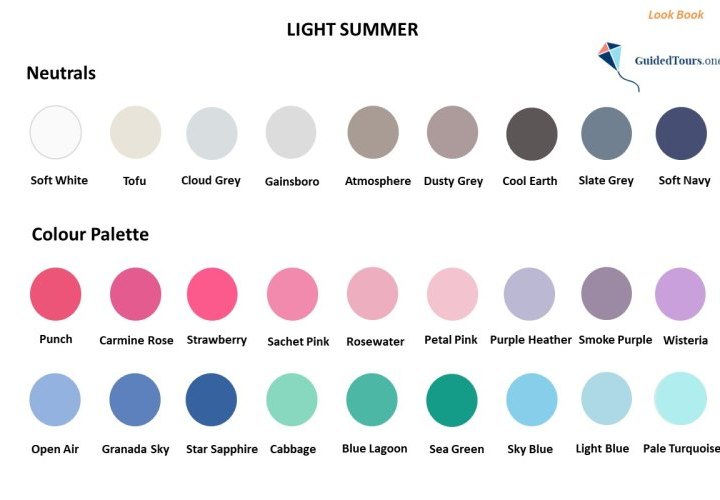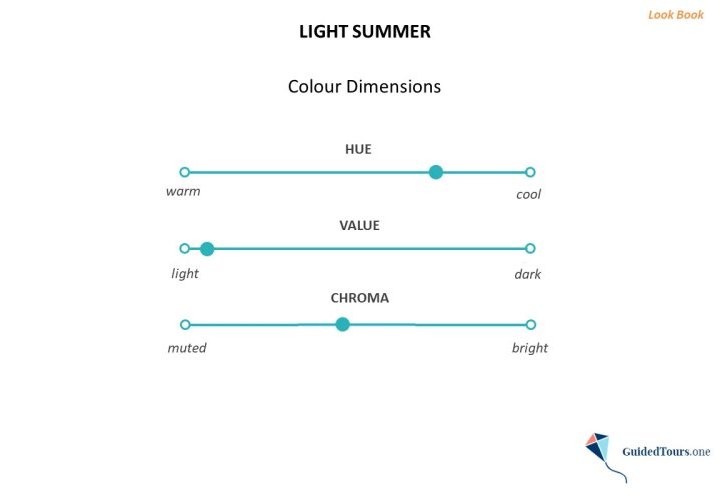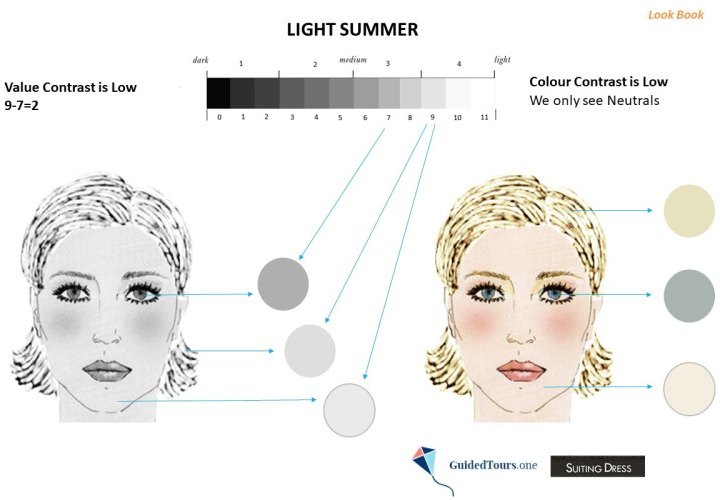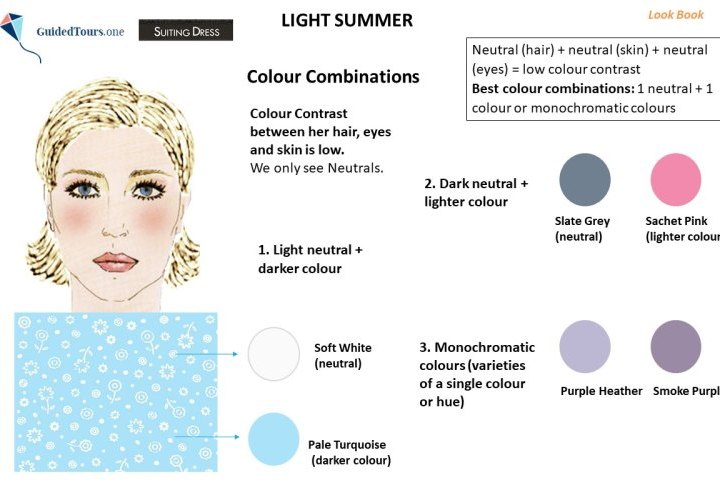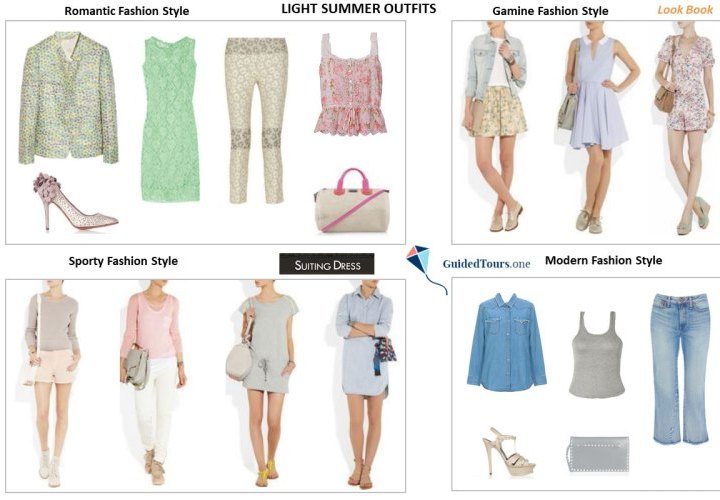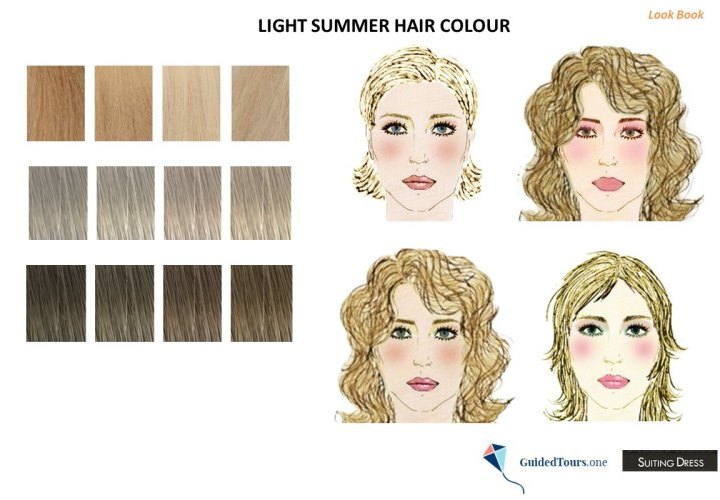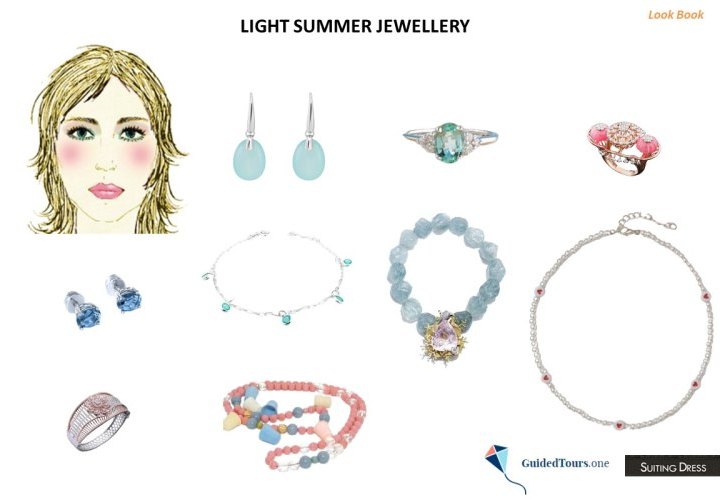Light Summer is the lightest season of the Summer family (Light Summer, True/Cool Summer and Soft Summer) and it sits between Light Spring and Cool (True) Summer on the seasonal flow chart. Unlike Light Spring, which has warm leaning neutral undertones, Light Summer has cool leaning neutral undertones. This season type is also different from Cool (True) Summer, which is completely cool.
If we examine the Colour Dimensions of Light Summer (image 2) we can see that it is first of all light, and then it is cool and after that soft (muted).
Hue: Cool/Neutral Cool (the hues of Light Summer are primarily cool, but as we can see on the image, they are not extremely cool and can also have some neutral undertones).
Value: Light (Light Summer is the lightest season of the Summer family, more
If we examine the Colour Dimensions of Light Summer (image 2) we can see that it is first of all light, and then it is cool and after that soft (muted).
Hue: Cool/Neutral Cool (the hues of Light Summer are primarily cool, but as we can see on the image, they are not extremely cool and can also have some neutral undertones).
Value: Light (Light Summer is the lightest season of the Summer family, more
and this is the main colour aspect of this season type).
Chroma: Medium-Soft (Light Summer has a medium-soft chroma, and it falls about in the middle of the scale)
Now, let’s examine the features (hair, skin tone, eyes) of Light Summer representatives.
Hair: Light Summer hair can be ashy such as very light ash blonde, light ash blonde, medium ash blonde, dark ash blonde and light ash brown, or ash lemon especially for Light Summers with pigmentation that leans into the warm. Typically, it doesn’t have natural highlights.
Skin tone: Light Summer skin can be fair, light or medium with cool leaning neutral undertones.
Eye Colours: Light Summer eyes are generally light grey, light or middle blue, light azure, light green or blue-green and can exhibit both a halo and cloudiness within the iris.
Colour Palette
Just like Light Summer’s primary colour dimensions, Light Summer colours are light, cool, and medium-soft to be in line with this season type natural colouring.
The overall Light Summer Colour Palette (image 1) contains some of the most refreshing colours of the summer family. The colours are mainly light or medium-light, but you can also find some colours that are darker.
The colours lean towards the cool end of the scale, but are not extremely cool. The colour palette includes many cool blues, purples, greens, and pinks and there are no harsh contrasts between the colours.
At the same time, there are many neutrals in the Light Summer palette, including soft white, cloud grey, cool earth, and soft navy. Light Summer neutrals include light neutrals, as well as darker ones, but not extremely dark. The similarity in value is needed to achieve a low value contrast, as the contrast between this season type features (you will find more details about this in the next section). Black and white are not included in the palette, but Light Summers have their own “version” of black and white in the palette, most often soft white and cool earth.
Light Summer worst colours are dark and warm, because they are opposed to light and cool, the main colour aspects of this season type.
Chroma: Medium-Soft (Light Summer has a medium-soft chroma, and it falls about in the middle of the scale)
Now, let’s examine the features (hair, skin tone, eyes) of Light Summer representatives.
Hair: Light Summer hair can be ashy such as very light ash blonde, light ash blonde, medium ash blonde, dark ash blonde and light ash brown, or ash lemon especially for Light Summers with pigmentation that leans into the warm. Typically, it doesn’t have natural highlights.
Skin tone: Light Summer skin can be fair, light or medium with cool leaning neutral undertones.
Eye Colours: Light Summer eyes are generally light grey, light or middle blue, light azure, light green or blue-green and can exhibit both a halo and cloudiness within the iris.
Colour Palette
Just like Light Summer’s primary colour dimensions, Light Summer colours are light, cool, and medium-soft to be in line with this season type natural colouring.
The overall Light Summer Colour Palette (image 1) contains some of the most refreshing colours of the summer family. The colours are mainly light or medium-light, but you can also find some colours that are darker.
The colours lean towards the cool end of the scale, but are not extremely cool. The colour palette includes many cool blues, purples, greens, and pinks and there are no harsh contrasts between the colours.
At the same time, there are many neutrals in the Light Summer palette, including soft white, cloud grey, cool earth, and soft navy. Light Summer neutrals include light neutrals, as well as darker ones, but not extremely dark. The similarity in value is needed to achieve a low value contrast, as the contrast between this season type features (you will find more details about this in the next section). Black and white are not included in the palette, but Light Summers have their own “version” of black and white in the palette, most often soft white and cool earth.
Light Summer worst colours are dark and warm, because they are opposed to light and cool, the main colour aspects of this season type.
Value Contrast
The value (or depth) shows how light or dark a colour is, while the value contrast is the level of difference in value between two or more colours. The closer together colours are, the lower is the level of contrast between them, and the farther apart colours are, the higher is the level of contrast.
Regardless of the values of Light Summer representatives features, there is usually a low value contrast between them.
On the image on your right, you can see a Light Summer representative with light hair and skin and medium-light eyes. In order to determine her value contrast level, we converted her photo into greyscale and assigned a value from 0 to 11 to her hair, skin, and eyes (9 to her hair, 9 to her skin, more
The value (or depth) shows how light or dark a colour is, while the value contrast is the level of difference in value between two or more colours. The closer together colours are, the lower is the level of contrast between them, and the farther apart colours are, the higher is the level of contrast.
Regardless of the values of Light Summer representatives features, there is usually a low value contrast between them.
On the image on your right, you can see a Light Summer representative with light hair and skin and medium-light eyes. In order to determine her value contrast level, we converted her photo into greyscale and assigned a value from 0 to 11 to her hair, skin, and eyes (9 to her hair, 9 to her skin, more
and 7 to her eyes). Next, we took the highest number and took away the lowest number (9-7=2). According to our value contrast scale that you can see below, she has a low value contrast.
A) 0 - 2 (low value contrast)
B) 3 - 5 (medium-low value contrast)
C) 6 - 8 (medium-high value contrast)
D) 9 - 11 (high value contrast)
The low value contrast, shows us that she can wear colours that provide a low value contrast and her clothes should not be more than 2 values apart.
Following this example, you can examine your own features and see if there is a low value contrast between them. Light Summers typically have a low value contrast between their features.
Colour Contrast
In terms of colour contrast, Light Summers typically have a low colour contrast, when their features are mostly neutral or a medium-low colour contrast, when two of their features are neutral, and one feature has a colour in it.
On the image on your right, you can see that the Colour Contrast of the same Light Summer representative selected by us is low, as we can only see neutrals in her features: neutral hair, neutral skin and neutral (grey) eyes. The best colour combinations will be: 1 neutral + 1 colour or monochromatic colours.
Following this example, you can examine your own features and see if there is a low colour contrast or a medium-low colour contrast between them. Light Summers typically have a low colour contrast or a medium-low colour contrast between their features.
A) 0 - 2 (low value contrast)
B) 3 - 5 (medium-low value contrast)
C) 6 - 8 (medium-high value contrast)
D) 9 - 11 (high value contrast)
The low value contrast, shows us that she can wear colours that provide a low value contrast and her clothes should not be more than 2 values apart.
Following this example, you can examine your own features and see if there is a low value contrast between them. Light Summers typically have a low value contrast between their features.
Colour Contrast
In terms of colour contrast, Light Summers typically have a low colour contrast, when their features are mostly neutral or a medium-low colour contrast, when two of their features are neutral, and one feature has a colour in it.
On the image on your right, you can see that the Colour Contrast of the same Light Summer representative selected by us is low, as we can only see neutrals in her features: neutral hair, neutral skin and neutral (grey) eyes. The best colour combinations will be: 1 neutral + 1 colour or monochromatic colours.
Following this example, you can examine your own features and see if there is a low colour contrast or a medium-low colour contrast between them. Light Summers typically have a low colour contrast or a medium-low colour contrast between their features.
As seen in the previous section, the value contrast between Light Summer features is low, while the colour contrast is low or medium-low.
Therefore, Light Summer representatives can combine colours that provide a low value contrast (taking into consideration the value contrast number), and the best combinations are those that repeat the value contrast level present in the appearance.
In terms of colour, the best colour combinations for Light Summers with neutral hair, skin and eyes will be 1 neutral and 1 colour or monochromatic colours, while the best colour combinations for Light Summers with two neutral features and one feature that has a colour in it will be 2 neutrals and 1 colour or monochromatic colours. This colour combination system was created by us and supposes 4 colour combination possibilities based on each season features colour. more
The best colour combinations for Light Summer representatives (image 1), who have a low colour contrast, are the following:
1. A light neutral + a darker colour or 1 neutral + 1 colour with the same value if your value contrast number is 0 (1 neutral + 1 colour)
2. A dark neutral + a lighter colour or 1 neutral + 1 colour with the same value if your value contrast number is 0 (1 neutral + 1 colour)
3. Monochromatic colours (varieties of a single colour or hue)
In terms of prints, the best patterns are those that only contain Light Summer colours, but if you can’t find a print that is completely within your palette, you can opt for a print that also has small colour spots from a disharmonious palette. The best prints for Light Summer are those that reflect the low natural contrast level rather than ones which are too bold. The abstract and watercolour-style patterns with natural, delicate elements such as feathers, birds, flowers and leaves are great for Light Summers. The elements of the pattern should be small, dense and loosely arranged, and any big elements and geometric shapes orderly arranged should be avoided, because they don’t go well with your delicate appearance.
On the image on your right, you can see a delicate abstract print with small, dense and loosely arranged elements that contains 1 neutral (soft white) and 1 colour (pale turquoise). Besides the appropriate low colour contrast, there is also a low value contrast in this print. If we convert the print into greyscale, we can see that soft white colour’s value is 10, but pale turquoise colour’s value is 8. If we take the highest number (10) and take away the lowest number (8) from this print we get 2 (10-8=2), which is also the natural value contrast number of this Light Summer representative. As both value and colour contrast are respected, you can notice how harmonious the print looks on the Light Summer representative chosen by us. At the same, all colour combinations that you can see on the image are only 2 values apart.
Light Summers have a delicate palette with many options for romantic style. On the image on your right (image 2), you can see some Light Summer Colour Palette Outfits ideas belonging to romantic, gamine, sporty, and modern fashion styles. You can experiment with the colours in your palette to create a low value contrast, and find the style that works better for you (or combine styles).
Therefore, Light Summer representatives can combine colours that provide a low value contrast (taking into consideration the value contrast number), and the best combinations are those that repeat the value contrast level present in the appearance.
In terms of colour, the best colour combinations for Light Summers with neutral hair, skin and eyes will be 1 neutral and 1 colour or monochromatic colours, while the best colour combinations for Light Summers with two neutral features and one feature that has a colour in it will be 2 neutrals and 1 colour or monochromatic colours. This colour combination system was created by us and supposes 4 colour combination possibilities based on each season features colour. more
The best colour combinations for Light Summer representatives (image 1), who have a low colour contrast, are the following:
1. A light neutral + a darker colour or 1 neutral + 1 colour with the same value if your value contrast number is 0 (1 neutral + 1 colour)
2. A dark neutral + a lighter colour or 1 neutral + 1 colour with the same value if your value contrast number is 0 (1 neutral + 1 colour)
3. Monochromatic colours (varieties of a single colour or hue)
In terms of prints, the best patterns are those that only contain Light Summer colours, but if you can’t find a print that is completely within your palette, you can opt for a print that also has small colour spots from a disharmonious palette. The best prints for Light Summer are those that reflect the low natural contrast level rather than ones which are too bold. The abstract and watercolour-style patterns with natural, delicate elements such as feathers, birds, flowers and leaves are great for Light Summers. The elements of the pattern should be small, dense and loosely arranged, and any big elements and geometric shapes orderly arranged should be avoided, because they don’t go well with your delicate appearance.
On the image on your right, you can see a delicate abstract print with small, dense and loosely arranged elements that contains 1 neutral (soft white) and 1 colour (pale turquoise). Besides the appropriate low colour contrast, there is also a low value contrast in this print. If we convert the print into greyscale, we can see that soft white colour’s value is 10, but pale turquoise colour’s value is 8. If we take the highest number (10) and take away the lowest number (8) from this print we get 2 (10-8=2), which is also the natural value contrast number of this Light Summer representative. As both value and colour contrast are respected, you can notice how harmonious the print looks on the Light Summer representative chosen by us. At the same, all colour combinations that you can see on the image are only 2 values apart.
Light Summers have a delicate palette with many options for romantic style. On the image on your right (image 2), you can see some Light Summer Colour Palette Outfits ideas belonging to romantic, gamine, sporty, and modern fashion styles. You can experiment with the colours in your palette to create a low value contrast, and find the style that works better for you (or combine styles).
Light Summer hair can be ashy such as very light ash blonde, light ash blonde, medium ash blonde, dark ash blonde and light ash brown, or ash lemon especially for Light Summers with pigmentation that leans into the warm. Typically, it doesn’t have natural highlights.
Usually, the best hair colour for Light Summers is their natural hair colour, but if you want to change your natural hair colour, you should opt for another Light Summer hair colour. Remember that your natural colour aspect is light, cool, and medium-soft and hair colour should also follow your natural colouring. Hair colours that provide too much contrast would dominate Light Summers look and overwhelm their delicateness. Ultimately, we all look our best when we are working with what is happening to us naturally, rather than drastically changing ourselves. more
Advising and choosing a new hair colour is, above all, respecting your low value contrast level and the natural cold base. Great hair colours for you would be all Light Summer natural hair colours mentioned above (taking into consideration your value contrast), as well as Nordic blonde, pearl tones (for example Light Pearl), soft platinum, or rose gold. On the image on your right, you can see how various Light Summer representatives look with ash blonde and ash lemon hair colours. If you decide to colour your hair, choose the colour with caution and avoid any warm blondes. It is important to stay in the same cool category so as not to create disharmony with the complexion.
Usually, the best hair colour for Light Summers is their natural hair colour, but if you want to change your natural hair colour, you should opt for another Light Summer hair colour. Remember that your natural colour aspect is light, cool, and medium-soft and hair colour should also follow your natural colouring. Hair colours that provide too much contrast would dominate Light Summers look and overwhelm their delicateness. Ultimately, we all look our best when we are working with what is happening to us naturally, rather than drastically changing ourselves. more
Advising and choosing a new hair colour is, above all, respecting your low value contrast level and the natural cold base. Great hair colours for you would be all Light Summer natural hair colours mentioned above (taking into consideration your value contrast), as well as Nordic blonde, pearl tones (for example Light Pearl), soft platinum, or rose gold. On the image on your right, you can see how various Light Summer representatives look with ash blonde and ash lemon hair colours. If you decide to colour your hair, choose the colour with caution and avoid any warm blondes. It is important to stay in the same cool category so as not to create disharmony with the complexion.
Light Summer colouring has neutral cool undertones, and silver is more harmonious with this season type skin undertone than gold. If you are a Light Summer, your best metals will be silver and platinum, but matte and brushed, not shiny. Rose gold is really nice but needs to be kept light to avoid going too bright or warm. Any jewellery that is bright and shiny, highly contrasted or with very dark elements will make you disappear behind it.
In terms of stones, rose quartz, amazonite, opal, chalcedony, aquamarine, rhodochrosite and sea glass are ideal for Light Summers. Matte pearls would also look great on Light Summers, but we suggest you to opt for faux pearls to show that you care about oysters and molluscs. Pearl extraction is not considered ethical, as oysters and other molluscs only produce pearls as a response to a stressful environment. more
In terms of stones, rose quartz, amazonite, opal, chalcedony, aquamarine, rhodochrosite and sea glass are ideal for Light Summers. Matte pearls would also look great on Light Summers, but we suggest you to opt for faux pearls to show that you care about oysters and molluscs. Pearl extraction is not considered ethical, as oysters and other molluscs only produce pearls as a response to a stressful environment. more
Faux pearls can be just as beautiful as natural pearls, and they are ethical.
On the image on your right, you can see some pieces of Light Summer jewellery including earrings, rings, and necklaces. Besides taking into consideration what earrings to wear based on your season type, you should also consider the following: 1) what earrings (shape and size) are best for your face shape; 2) how to combine earrings with your dress style (for example modern, classic, sophisticated, etc.).
If you are not sure whether you are a Light Summer or not, you can contact us for an Online Personal Colour Analysis or purchase the Self Seasonal Colour Analysis Guide (15 €).
On the image on your right, you can see some pieces of Light Summer jewellery including earrings, rings, and necklaces. Besides taking into consideration what earrings to wear based on your season type, you should also consider the following: 1) what earrings (shape and size) are best for your face shape; 2) how to combine earrings with your dress style (for example modern, classic, sophisticated, etc.).
If you are not sure whether you are a Light Summer or not, you can contact us for an Online Personal Colour Analysis or purchase the Self Seasonal Colour Analysis Guide (15 €).

